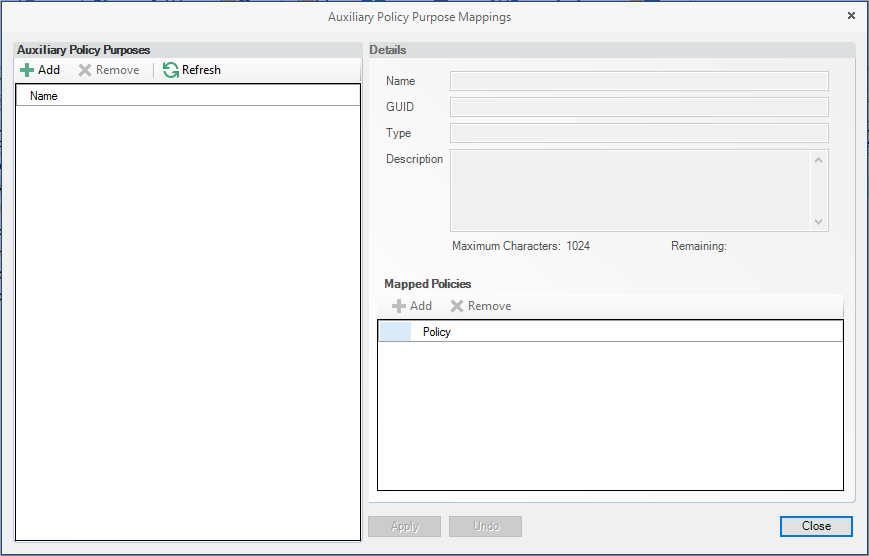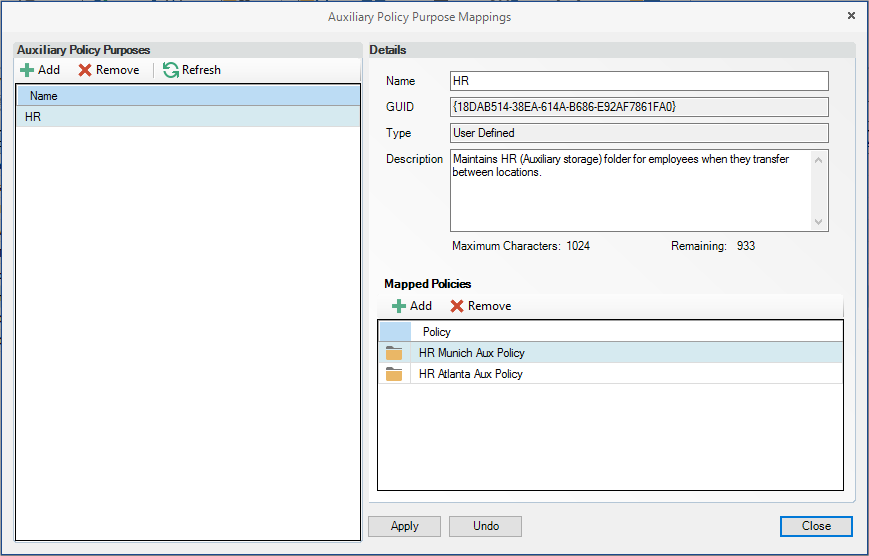5.7 Using a Policy to Manage Auxiliary Storage
Auxiliary storage allows administrators to create a policy that creates auxiliary storage folders when a new user is created. This auxiliary storage can even be invisible to the user for whom it was created.
For example, an organization's HR department might keep an individual folder for each user in the organization. With auxiliary user storage enabled, this folder can be created when the user joins the company and Storage Manager for eDirectory creates and provisions his or her home folder. The user never sees the auxiliary storage.
Additionally, the auxiliary storage can be as large as the policy specifies. This means that even though the user's home directory might have 500 MB, the auxiliary storage could be as small as the HR department needed it to be for storing HR-specific documents about the user. In fact, the policy can dictate that the auxiliary storage is provisioned with needed HR documents at the time the auxiliary storage is created.
Of course, you can configure auxiliary user storage so that a user can access it. For example, you might want to have a separate storage folder for application-specific files. It is important to remember that auxiliary storage is simply another home folder for a user. To provide access to this storage, you need to provide some sort of mapping for the user to get automated access to it.
There is no limit to the number of auxiliary folders that can be created. Auxiliary folders can be created in volumes that differ from the location of the user's home folder.
Storage Manager's life cycle management capabilities easily manage auxiliary storage to the specific needs of the organization. For example, if a user transfers from one city to another and the user home folder is moved to a new Organizational Unit object as a result, the policy can dictate what becomes of the auxiliary storage including moving it, moving it and adjusting the quota settings, leaving it where it currently is, etc. For more information on moving Auxiliary storage, see Section 5.7.4, Establishing Auxiliary Purpose Mappings.
5.7.1 Creating an Auxiliary Storage Policy
-
In the Admin Client, click Policy Management.
-
From the Manage drop-down menu, select New > Auxiliary.
-
Specify a descriptive name in the Name field, such as “HR-AUX,” and click OK.
The Policy Options page appears.
-
Proceed with Setting Auxiliary Storage Policy Options.
Setting Auxiliary Storage Policy Options
-
Leave the Process Events for Associated Managed Storage check box selected.
-
Proceed with Enabling Auxiliary Storage Extended Options.
Enabling Auxiliary Storage Extended Options
Auxiliary storage extended options help other tools identify the auxiliary storage policy through additional attributes.
-
In the left pane, click Extended Options.
-
Click the Enable check box.
-
In the Tag field, enter a descriptive string for the auxiliary storage.
Micro Focus recommends that once you have made an entry in the Tag field, that you do not change it. If the value of the Tag field is changed after some users have already had their auxiliary storage provisioned via that policy, the new tag value does not automatically get propagated to those users. Only users who get storage provisioned after the change in the tag value will get the new tag value.
-
In the Description field, specify a description of the auxiliary storage policy.
-
Click Apply to save your settings.
-
Proceed with Setting Auxiliary Storage Provisioning Options.
Setting Auxiliary Storage Provisioning Options
Before setting the provisioning options, you need to decide whether the user should have rights to auxiliary storage.
Additionally, if you are going to provision auxiliary storage folders with a certain structure or with specific documents, you need to place them somewhere in the file system so you can use them as a template. For example, if the HR department wants the auxiliary storage folder to have an Annual Reviews folder and an Insurance Forms folder, you need to set these up in the file system before proceeding.
-
In the left pane, click Provisioning Options.
-
Do one of the following:
-
If you do not want the associated user to have access to the auxiliary storage folder, deselect all of the Default Rights check boxes.
-
If you want the associated user to have access to the auxiliary storage folder, select the appropriate rights from the Default Rights check boxes.
-
-
In the Template Folder region, click the Browse button, and then specify the template path in the Path Browser dialog box.
-
Click Apply to save your settings.
Setting Additional Auxiliary Storage Options
-
Select the additional options that you want to use in the Auxiliary Storage policy.
Auxiliary Storage Target Paths: You need to specify the location where the auxiliary storage folders are to be located. For example, if these were HR Department folders, they would probably be located on a network volume specific to the HR Department.
The fields presented on the Target Paths page are identical to those presented when you create a User Home Folder policy. For an explanation of the page along with procedures for setting target paths, see Section 5.4.4, Setting Target Paths.
Auxiliary Storage Quota Options: You need to specify the quota for the auxiliary storage folder associated with a user. In many cases, such as the HR Department example, this folder can be much smaller that the home folder.
The fields presented on the Quota Options page are identical to those presented when you create a User Home Folder policy. For an explanation of the page, along with procedures for setting quota options, see Section 5.4.5, Setting Quota Options.
Auxiliary Storage Move Schedule: The fields presented on the Move Schedule page are identical to those presented when you create a user home folder policy. For an explanation of the page, along with procedures for setting the move schedule, see Section 5.4.6, Setting the Move Schedule.
Auxiliary Storage Cleanup Options: The fields presented on the Cleanup Options page are identical to those presented when you create a User Home Folder policy. For an explanation of the page, along with procedures for setting cleanup options, see Section 5.4.7, Setting Cleanup Options.
Auxiliary Storage Vault Rules: The fields presented on the Vault Rules page are identical to those presented when you create a User Home Folder policy. For an explanation of the page, along with procedures for setting vault rules, see Section 5.4.8, Setting Vault Rules.
Auxiliary Storage Grooming Rules: The fields presented on the Grooming Rules page are identical to those presented when you create a user home folder policy. For an explanation of the page, along with procedures for setting grooming rules, see Section 5.4.9, Setting Grooming Rules.
-
Proceed with Section 5.7.2, Linking a User Home Folder Policy to an Auxiliary Storage Policy.
5.7.2 Linking a User Home Folder Policy to an Auxiliary Storage Policy
This procedure connects the Auxiliary Storage policy with an existing User Home Folder policy. All new users that are added to a group or organizational unit associated with the linked user home folder policy will also have auxiliary storage created. To provide existing users with auxiliary storage, see Section 5.7.3, Provisioning Auxiliary Storage for Existing Users.
-
In the Admin Client, click the Main tab.
-
Click Policy Management.
-
In the list of policies, double-click the policy you want to link to the auxiliary storage policy.
-
In the left pane of the Policy Editor, click Auxiliary Policies.
-
Click Add. In the Policy Selector dialog box, select the Auxiliary Storage policy, then click OK.
-
Click OK to exit the Policy Editor.
5.7.3 Provisioning Auxiliary Storage for Existing Users
This procedure lets Storage Manager for eDirectory manage an existing second user home folder by classifying the second home folder as an auxiliary storage folder and managing it through an auxiliary storage policy. In the process, Storage Manager for eDirectory corrects any potential problems.
-
In the Admin Client, click the Main tab.
-
Click Policy Management.
-
Select the auxiliary storage policy linked to the User Home Folder policy of the users for whom you want to create auxiliary storage.
-
In the Actions drop-down menu, select Assign Auxiliary Attributes.
-
Verify that the Assign using value in policy is Auxiliary Attribute is not set option is selected.
This option uses the defined auxiliary storage policy path and looks for a folder that matches the common name of all users defined within the policy. If a match is found, the Auxiliary Storage Attribute is set and the users are cataloged and managed by the Auxiliary Storage policy.
-
Verify that the Run in Check Mode check box is selected and click Run.
Run in Check Mode allows you to view the results of an action without actually making changes.
-
Click Expand to see the results.
Note that the Auxiliary Attribute is set for each folder that matches a User object.
-
Click Collapse.
-
Deselect Run in Check Mode and click Run to set the Auxiliary Attribute.
-
From the Actions drop-down menu, select Apply Quota.
-
Select Set quota for all directories. Overwrite any existing quota assignments except where the existing quota is larger than the quota defined in the policy.
-
Select Run in Check Mode and click Run to view the results.
-
Deselect Run in Check Mode, then click Run to put auxiliary storage into effect for existing users.
5.7.4 Establishing Auxiliary Purpose Mappings
Auxiliary purpose mappings are the means of moving a user’s auxiliary storage when a user is moved in eDirectory. For example, if a user were moved from the Atlanta container to the Detroit container, and the two container’s Auxiliary storage policies were part of the same Auxiliary purpose mapping, the user’s Auxiliary storage would move to the Detroit Auxiliary storage location.
WARNING:If there is no established Auxiliary purpose mapping between the source and destination container, the user’s auxiliary storage is deleted once the user is moved.
-
In the Admin Client, click the Main tab.
-
Click Policy Management.
-
From the Manage drop-down menu, select Auxiliary Purpose Mappings.

-
Click Add.
-
Give the new Auxiliary purpose mapping a descriptive name.
For example, “HR.”
-
Click OK.
-
In the Mapped Policies region, click Add.
-
From the Policy Selector dialog box, hold down the Control key to select each of the Auxiliary storage policies you want associated with the Auxiliary purpose mapping.
Using the example above, you would select the Auxiliary storage policy for the Atlanta container, the Detroit container, and any others you want included.
-
Click OK.
-
In the Description field, specify the details of the Auxiliary storage purpose mapping.

-
Click Apply.
-
Click Close.